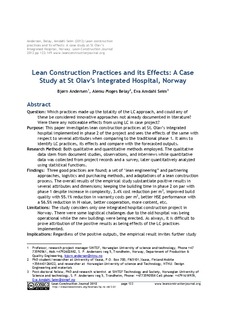| dc.contributor.author | Andersen, Bjørn | |
| dc.contributor.author | Belay, Alemu Moges | |
| dc.contributor.author | Seim, Eva Amdahl | |
| dc.date.accessioned | 2020-02-06T12:14:33Z | |
| dc.date.available | 2020-02-06T12:14:33Z | |
| dc.date.created | 2013-01-02T09:46:45Z | |
| dc.date.issued | 2012 | |
| dc.identifier.citation | Lean Construction Journal. 2012, 2012 122-149. | nb_NO |
| dc.identifier.issn | 1555-1369 | |
| dc.identifier.uri | http://hdl.handle.net/11250/2640034 | |
| dc.description.abstract | Question: Which practices made up the totality of the LC approach, and could any of these be considered innovative approaches not already documented in literature? Were there any noticeable effects from using LC in case project? Purpose: This paper investigates lean construction practices at St. Olav’s integrated hospital implemented in phase 2 of the project and sees the effects of the same with respect to several attributes when comparing to the traditional phase 1. It aims to identify LC practices, its effects and compare with the forecasted outputs. Research Method: Both qualitative and quantitative methods employed. The qualitative data stem from document studies, observations, and interviews while quantitative data was collected from project records and a survey, later quantitatively analyzed using statistical functions. Findings: Three good practices are found; a set of ‘lean engineering” and partnering approaches, logistics and purchasing methods, and adaptations of a lean construction process. The overall results of the empirical study substantiate positive results in several attributes and dimensions; keeping the building time in phase 2 on par with phase 1 despite increase in complexity, 3.4% cost reduction per m2 , improved build quality with 55.1% reduction in warranty costs per m2 , better HSE performance with a 56.5% reduction in H value, better cooperation, more content, etc. Limitations: The study considers only one integrated hospital construction project in Norway. There were some logistical challenges due to the old hospital was being operational while the new buildings were being erected. As always, it is difficult to prove attribution of the positive results as being effects of the LC practices implemented. Implications: Regardless of the positive outputs, the empirical result invites further study | nb_NO |
| dc.language.iso | eng | nb_NO |
| dc.publisher | Lean Construction Institute | nb_NO |
| dc.relation.uri | http://www.leanconstruction.org/lcj/2012/LCJ_12_003.pdf | |
| dc.rights | Attribution-NonCommercial-NoDerivatives 4.0 Internasjonal | * |
| dc.rights.uri | http://creativecommons.org/licenses/by-nc-nd/4.0/deed.no | * |
| dc.subject | Lean construction | nb_NO |
| dc.subject | Norway | nb_NO |
| dc.subject | St. Olavs hospital | nb_NO |
| dc.title | Lean Construction Practices and its Effects: A Case Study at St Olav’s Integrated Hospital, Norway | nb_NO |
| dc.type | Journal article | nb_NO |
| dc.type | Peer reviewed | nb_NO |
| dc.description.version | publishedVersion | nb_NO |
| dc.rights.holder | http://creativecommons.org/licenses/by-nc-nd/3.0/ | nb_NO |
| dc.source.pagenumber | 122-149 | nb_NO |
| dc.source.volume | 2012 | nb_NO |
| dc.source.journal | Lean Construction Journal | nb_NO |
| dc.identifier.cristin | 978794 | |
| cristin.unitcode | 7401,90,30,0 | |
| cristin.unitname | Teknologiledelse | |
| cristin.ispublished | true | |
| cristin.fulltext | original | |
| cristin.qualitycode | 1 | |

